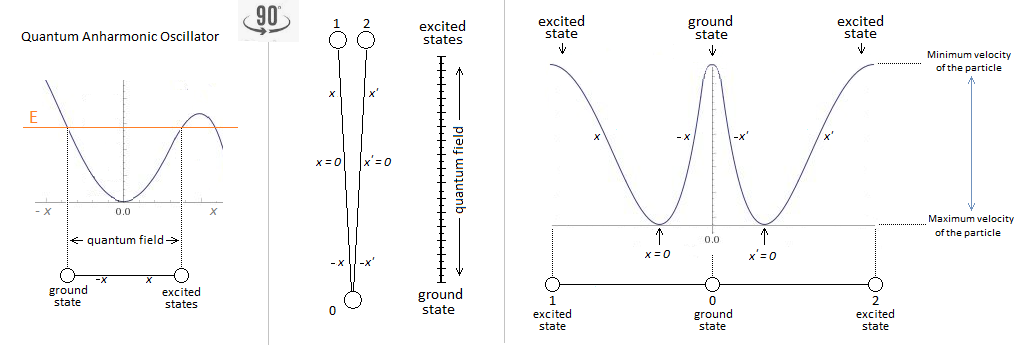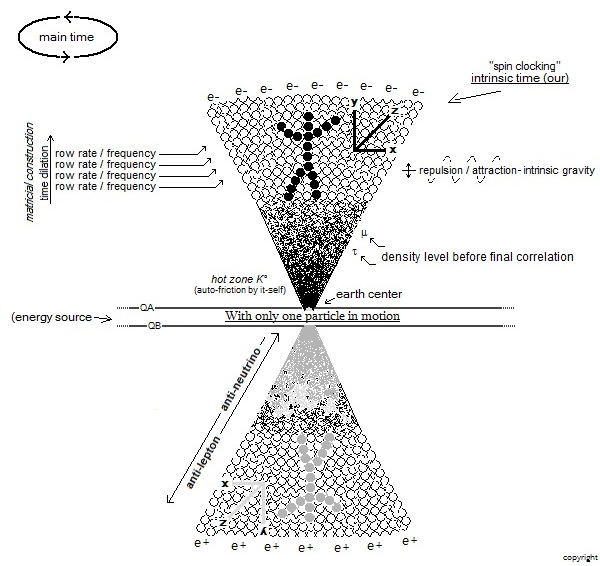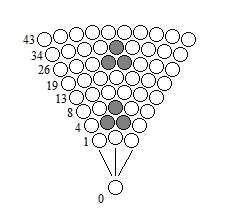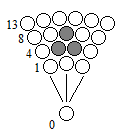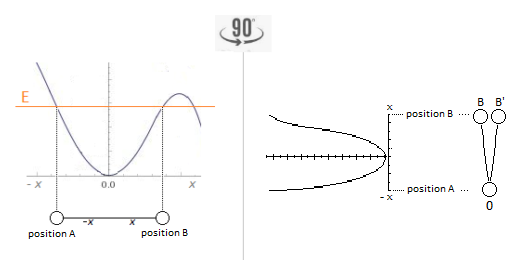-
Posts
569 -
Joined
-
Last visited
-
Days Won
1
Content Type
Profiles
Forums
Events
Everything posted by Kartazion
-
Yes. This time is identify for my part of the main time. This main time elapses in all cases, whether there is creation of an oscillation or not. I will explain myself later on this point. The main time includes the oscillation, if there is oscillation ; but the oscillation itself, with the particle, creates an intrinsic time son of main time. Obviously it's a bit technical. I am not using the oscillation as a clock, but rather an increlmentation of the position of the particle which it creates an intrinsic time between each position. From postion B to postion B' there is an intrinsic time step, then we have the phase of oscillation which lasts, and the main time that elapses. To this is added the dilation. Otherwise, if I'm wrong, there will be a transformation, not of Lorenz, but similar to explain it with CTC. I estimate a minimum of one more year to be able to explain reasonably what I have started to tell. I started with this:
-
Quite simply, isn't the phase position of an oscillator? Upon retraction, the particle returns to its original starting point to then retrace this line, and following the expansion? This implies that there is a constant connection between the big bang singularity and the matter. Ps: It is always an honor to be able to talk with an expert, which is not my case. Thanks everyone for that.
-
As I will go into speculation I can already give a draft. But give me some day to better explain it. Time dilation: Here is an example of a triangle-shaped object of a spherical structure: Legend of the distribution of time granted from the effective position: po = origin point = 0,0001ns (position A) → = flow = ~0s (distance between A et B) point(n) = dot matrix = 1ns (position B) (po–>point1–>po–>point2–>po–>point3–>) = line1 = ~3,0003ns (po–>point4–>po–>point5–>po–>point5–>po–>point6–>po–>point6–>po–>point7–>) = line2 = ~6,0006ns (po–>point8–>po–>point9–>po–>point10–>po–>point10–>po–>point11–>po–>point12–>) = line3 = ~6,0006ns (po–>point13–>po–>point14–>po–>point15–>po–>point16–>po–>point17–>po–>point18–>) = line4 = ~6,0006ns (line1 + line2 + line3 + line4) = cycle cycle x frequency From the first to the last point of the complete object, will be formed in about 9ns (~ 9,0009ns) for one cycle. The total refresh of the structure ends in about 21ns (~ 21,0021ns) for one cycle. Here if we continue this same structure with additional lines to form a second object in the form of an identical triangle called object2, we have: (po–>point19–>po–>point20–>po–>point21–>po–>point22–>po–>point23–>po–>point24–>po–>point25–>) = line5 = ~7,0007ns (po–>point26–>po–>point27–>po–>point28–>po–>point29–>po–>point29–>po–>point30–>po–>point30–>po–>point31–>po–>point32–>po–>point33–>) = line6 = ~10,0010ns (po–>point34–>po–>point35–>po–>point36–>po–>point37–>po–>point38–>po–>point38–>po–>point39–>po–>point40–>po–>point41–>po–>point42–>) = line7 = ~10,0010ns (po–>point43–>po–>point44–>po–>point45–>po–>point46–>po–>point47–>po–>point48–>po–>point49–>po–>point50–>po–>point51–>po–>point52–>) = line8 = ~10,0010ns (line1 + line2 + line3 + line4 + line5 + line6 + line7 + line8) = cycle cycle x frequency The object2 is formed around 13ns (~ 13,0013ns). Either the same object is about 4ns longer on the high lines of the structure, than its double in ~ 9,0009ns on the low lines. The object2 on the upper part of the structure is about 4ns older than its brother on the lower part. Because the effective position sweeps all the free positions end to end, it is logical to find in this case the extension of time when forming entirely identical objects. Subsequently we can understand that the movement of the object2 annihilates the scanning of the effective position, and thus the object2 is formed faster than if it remains motionless.
-
I thought that the worldline is the flow of the particle between its two positions of A and B.
-
But you can see the http? If it's without the s, do not connect with a login and password, because it means that your connection is not secure. In this case you must reset your OS (windows or mac) But you should at least see the padlock on the web browser.
-
Moderation will have to split. Position A or 0 does not move. Only the position B can be different. The particle therefore oscillates between A and B, and then between A and B' To be exact the cycle of oscillation is A → B → A → B'→ A I don't know if you understand what I'm trying to explain. But give me some time to write something more explicit There is also this article https://physics.aps.org/articles/v13/99
-
Maybe something with UTF-8? Do you always have the https padlock in the address? This is at first sight the most important. But the problem probably comes from the web browser. But it may be something else. Once I had a pc that had caught the humidity, and was having at the start the problem of writing characters on the screen...
-
I think the solution is in /usr/sbin/sshd file. https://linux.die.net/man/8/sshd So I recovered the source of it with: wget -c https://cdn.openbsd.org/pub/OpenBSD/OpenSSH/portable/openssh-8.0p1.tar.gz and decompress with: tar -xzf openssh-8.0p1.tar.gz Now I try to see where I can insert my code before compilation with ./configure -h There are several interesting files related to the deamon. If you have any idea which one... The purpose of this manipulation is to be able to create a log list of the connection listening on a dot matrix printer. IOW for each connection attempt, my printer lists the client's information into /dev/tcp/192.168.x.x As said above we already have this information in /var/log.
-
I had already made this example of CTC. It comes from an oscillator
-
Yes it's ambiguous for others who Demystifies Entanglement and Quantum Nonlocality or find A Closer Connection Between Entanglement and Nonlocality But I understood that both have nothing to do. It is true that the correlation was subject to debate namely the transfer comes at the start or after. For the rest it is a nice explanation. Thank you
-
Normally I use tcpdump in shell which is like wireshark in graph. But these programs list the listening and give the IP as well as its destination port. But maybe you want me to understand that in the packets there would be the call of the file or the service on the server? Good idea. I'm going to try on 127.0.0.1
-
Being on no computer forum, I try here to expose my problem. Indeed I want to create and manage a specific log file (we already have /var/log which runs it) but I want to intercept the bits/words of these instructions. What are the files and the directory that starts the execution of the first instruction when we calling ssh or sftp? Knowing that there are the sftp or ssh deamons that listen and the /bin/ssh or /bin/sftp scripts that start the service. I thought it was just the files in the /bin directory that started when calling the service. This would therefore amount to recompliling the /bin files. There may also be the solution of PID Process. Thanks.
-
The sentence came from wikipedia, as well as the following: In physics, action at a distance is the concept that an object can be moved, changed, or otherwise affected without being physically touched (as in mechanical contact) by another object. That is, it is the non-local interaction of objects that are separated in space. and from quantum information (not theory) https://en.wikipedia.org/wiki/Quantum_information Any change in state of one entangled particle automatically affects the other. We must therefore be able to explain how "information" is transmitted from one entangled particle to another. The "information" can be given just before entanglement by hidden variable and retained in memory during the entanglement, for after discovering its state(s). Or the information is given later and is transmitted from one entangled particle to another when we want to read its states. This is why we speak of nonlocality and action at a distance for this specific observed case. This is valid for the quantum teleportation. @Markus Hanke ?
-
But this rule is related to an observer, not an observable since the observable can be indicative for both observers. In other words if the spin is read from one side, then the spin of the other entangled particle can be read at an opposite value. There you have the Action at distance https://en.wikipedia.org/wiki/Action_at_a_distance That is, it is the non-local interaction of objects that are separated in space.
-
In the principle of nonlocality or not: Either the information is given at the start of the entanglement, then the information is given thereafter until it is read; Or the information is given later when we discover the state of one of the two praticles which acts on the other not instantly at c speed?

